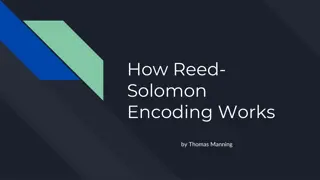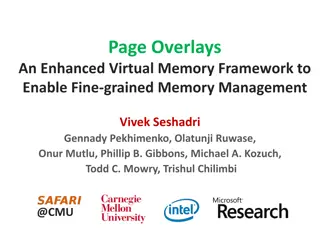ConCORD: Exploiting Memory Content Redundancy Through Content-aware Services
Memory content-sharing detection and tracking are crucial aspects that should be built as separate services. ConCORD, a distributed system, efficiently tracks memory content across entities like VMs and processes, reducing memory footprint size and enhancing performance. The implementation involves a content-aware service command with collective checkpoint functionality, resulting in a streamlined approach to handling memory content sharing in parallel systems.
- Memory Content Sharing
- ConCORD
- Content-aware Services
- Memory Footprint Reduction
- Distributed Systems
Download Presentation

Please find below an Image/Link to download the presentation.
The content on the website is provided AS IS for your information and personal use only. It may not be sold, licensed, or shared on other websites without obtaining consent from the author. Download presentation by click this link. If you encounter any issues during the download, it is possible that the publisher has removed the file from their server.
E N D
Presentation Transcript
ConCORD: Easily Exploiting Memory Content Redundancy Through the Content-aware Service Command Lei Xia, Kyle Hale, Peter Dinda Hobbes: http://xstack.sandia.gov/hobbes/ HPDC 14, Vancouver, Canda, June 23-27
Overview Claim: Memory content-sharing detection and tracking should be built as a separate service Exploiting memory content sharing in parallel systems through content-aware services Feasibility: Implementation of ConCORD: A distributed system that tracks memory contents across collections of entities (vms/processes) Content-aware service command minimizes the effort to build various content-aware services Collective checkpoint service Only ~200 line of code 2
Outline Content-sharing in scientific workloads Content-aware services in HPC Content-sharing tracking as a service Architecture of ConCORD Implementation in brief Content-aware service command Collective checkpoint on service command Performance evaluation Conclusion 3
Content-based Memory Sharing Eliminate identical pages of memory across multiple VMs/processes Reduce memory footprint size in one physical machine Intra-node deduplication [Barker-USENIX 12] 4
Memory Content Sharing is Common in Scientific Workloads in Parallel Systems [previous work published at VTDC 12] Total Memory Intra-node Distinct Inter/Intra Distinct 2097152 1048576 524288 262144 # of memory pages 131072 65536 32768 16384 8192 4096 2048 5
Memory Content Sharing in Parallel Workloads [previous work published at VTDC 12] Both Intra-node and inter-node sharing is common in scientific workloads, Many have significant amount of inter-node content sharing beyond intra-node sharing [A Case for Tracking and Exploiting Inter-node and Intra-node Memory Content Sharing in Virtualized Large-Scale Parallel Systems, VTDC 12] 6
Content-aware Services in HPC Many services in HPC systems can be simplified and improved by leveraging the intra- /inter-node content sharing Content-aware service: service that can utilize memory content sharing to improve or simplify itself Content-aware checkpointing Collectively checkpoint a set of related VMs/Processes Collective virtual machine co-migration Collectively moving a set of related VMs Collective virtual machine reconstruction Reconstruct/migrate a VM from multiple source VMs, Many other services . 7
Content-aware Collective Checkpointing P3 P1 P2 A B A A B C D E C D E C A B E C A B E F F A B C D A B C D C G G Checkpoint 8
Content-aware Collective Checkpointing P3 P1 P2 B A B C D E A B C D E A D C A B E C A B E E F F F A B C D A B C D C C G G G A B C D G A B C D E C A B E F Checkpoint Collective-checkpoint Reduce checkpoint size by saving only one copy of each distinct content (block) across the all processes 9
Collective VM Reconstruction Host-1 Host-2 Host-3 A B C D G VM-2 VM-1 VM-3 A B C D E C A B E F Host-4 Single VM Migration 10
Collective VM Reconstruction Host-1 Host-2 Host-3 A B C D G C VM-2 VM-1 D VM-3 A B C D E A C A B E B F G Host-4 Collective VM Reconstruction 11
Collective VM Reconstruction Host-1 Host-2 Host-3 A B C D G C VM-2 VM-1 D A B C D E A C A B E B F G Host-4 A B C D G VM-3 Collective VM Migration Fasten VM migration by reconstructing its memory from multiple sources 12
Content-sharing Detection and Tracking We need to detect and track memory content sharing Continuously tracking with system running Both intra-node and inter-node sharing Scalable in large scale parallel systems with minimal overhead 13
Content-sharing Tracking As a Service Content sharing tracking should be factored into a separate service Maintain and enhance a single implementation of memory content tracking Allow us to focus on developing an efficient and effective tracking service itself Avoid redundant content tracking overheads when multiple services exist Much easier to build content-aware services with existing tracking service 14
ConCORD: Overview A distributed inter-node and intra-node memory content redundancy detection and tracking system Continuously tracks all memory content sharing in a distributed memory parallel system Hash-based content detection Each memory block is represented by a hash value (content hash) Two blocks with the same content hash are considered as having same content 15
ConCORD: System Architecture node node VM Process Memory Update Monitor ptrace Content-aware Service inspect Memory Update Monitor Hypervisor (VMM) OS Content-sharing Query Interface Content-aware Service Command Controller Memory Content Update Interface ConCORD Service Command Execution Engine Distributed Memory Content Tracer nodes 16
Distributed Memory Content Tracer Uses customized light-weight distributed hash table (DHT) To track memory content sharing, and location of contents in system-wide Conventional DHT DHT in ConCORD Large-scale Parallel Systems Target System Distributed Systems Type of key variable length fixed length variable size, variable format Type of object small size Fault Tolerance Strict Loose Persistency Yes No 17
DHT in ConCORD DHT Entry: <content-hash, Entity-List> DHT content is split into partitions, and distributed (stored and maintained) over the ConCORD instances Given a content hash, computing its partition and its responsible instance is fast and straightforward: zero-hop no peer information is needed 18
Content-sharing Queries Examine memory content sharing and shared locations in system Node-wise queries Given a content hash: Find number of copies existing in a set of entities Find the exact locations of these blocks Collective Queries Degree of Sharing: Overall level of content redundancy among a set of entities Hot memory content: contents duplicate more than k copies in a set of entities 19
How can we build a content-aware service? Runs content-sharing queries inside a service Uses sharing information to exploit content sharing and improve service Requires many effort from service developers how efficiently and effectively utilize the content sharing 20
How can we build a content-aware service? Runs a service inside a collective query ConCORD provides query template Service developer defines a service by parametering the query template ConCORD executes the parameterized query over all shared memory content During run of the query, ConCORD completes the service while utilizes memory content sharing in the system Minimize service developers effort 21
Content-aware Service Command A service command is a parameterable query template Services built on top of it are automatically parallelized and executed by ConCORD partitioning of the task scheduling the subtasks to execute across nodes managing all inter-node communication 22
Challenge: Correctness vs. best-effort ConCORD provides best-effort service ConCORD DHT s view of memory content may be outdated Application services require correctness Ensure correctness using best-effort sharing information 23
Service Command: Two Phase Execution Collective Phase: Each node performs subtasks in parallel on locally available memory blocks Best-effort, using content tracked by ConCORD Stale blocks are ignored Driven by DHT for performance and efficiency Local Phase Each node performs subtasks in parallel on memory blocks ConCORD does know of All fresh blocks are covered Driven by local content for correctness 24
Collective Checkpoint: Initial State Memory content in processes A B C D E P-1 C A B E F P-2 A B C D G P-3 25
Collective Checkpoint: Initial State Memory content in processes Memory content in ConCORD s view A B C D E P-1 A B C D E P-1 C A B E F P-2 C A B E F P-2 A B C D H P-3 A B C D G P-3 26
Collective Checkpoint: Initial State Memory content in processes Memory content in ConCORD s view A B C D E P-1 A B C D E P-1 C A B E F P-2 C A B E F P-2 A B C D H P-3 A B C D G P-3 Content Hash Process Map A {p1, p2, p3} B {p1, p2, p3} ConCORD s DHT C {p1, p2, p3} D {p1, p3} E {p1, p2} F {p2} H {p3} 27
Collective Checkpoint: Collective Phase A B C D E P-1 ConCORD Service Execute Engine C A B E F P-2 A B C D G P-3 28
Collective Checkpoint: Collective Phase A B C D E P-1 Save {A,D} ConCORD Service Execute Engine Save {B, E, F} C A B E F P-2 A B C D G Save {C,H} P-3 29
Collective Checkpoint: Collective Phase A B C D E P-1 ConCORD Service Execute Engine C A B E F P-2 A B C D G P-3 30
Collective Checkpoint: Collective Phase A B C D E P-1 {A,D} saved ConCORD Service Execute Engine {B, E, F} saved C A B E F P-2 {C} saved A B C D G P-3 31
Collective Checkpoint: Collective Phase A B C D E P-1 {A,D} saved ConCORD Service Execute Engine {B, E, F} saved C A B E F P-2 {C} saved A B C D G P-3 Completed: {A, B, C, D, E, F} 32
Collective Checkpoint: Local Phase A B C D E P-1 {A, B, C, D, E, F} ConCORD Service Execute Engine {A, B, C, D, E, F} C A B E F P-2 A B C D G {A, B, C, D, E, F} P-3 Local Phase: P-1: Do Nothing P-2: Do Nothing P-3: Save G 33
Example Service: Collective Checkpoint User-defined Service Specific Functions: Function executed during collective phase: For request content hash: If (a local block exists locally): save the memory block into user-defined file Function executed during local phase: For each local memory block if(block is not saved): saves the block to user-defined file Implementation: 220 lines of C code. (Code in Lei Xia s Ph.D Thesis). 34
Performance Evaluation Service Command Framework Use a service class with all empty methods (Null Service Command) Content-aware Collective Checkpoint Testbed IBM x335 Cluster (20 nodes) Intel Xeon 2.0 GHz/1.5 GB RAM 1 Gbps Ethernet NIC (1000BASE-T) HPC Cluster (500 nodes) Two quadcore 2.4 GHz Intel Nehalem/48 GB RAM InfiniBand DDR network 35
Null Service Command Execution Time Linearly Increases with Total Memory Size 4500 4000 3500 Service Time (ms) 3000 2500 2000 1500 1000 500 0 256 512 1024 2048 4096 8192 Memory Size per process (6process, 6nodes) Execution time is linear with total process memory size 36
Null Service Command Execution Time Scales with Increasing Nodes 800 700 600 Service Time (ms) 500 400 300 200 100 0 1 2 4 8 12 Number of Nodes (1process/node, 1GB/process) 37
Null Service Command Execution Time Scales in Large Testbed 38
Checkpoint Size: Runs application with plenty of inter-node content sharing, ConCORD achieves better compression ratio 100% Raw-gzip ConCORD 80% Compression Ratio (%) 60% 40% 20% 0% 1 2 Number of Nodes (Moldy, 1process/node) 4 6 8 12 16 39
Checkpoint Size: ConCORD achieves better compression ratio 100% Raw-gzip ConCORD ConCORD-gzip 80% Content-aware checkpointing achieves better compression than GZIP for applications with many inter-node content sharing Compression Ratio 60% 40% 20% 0% 1 2 Number of Nodes (Moldy, 1process/node) 4 6 8 12 16 40
Collective Checkpoint Checkpoint Time Scales with Increasing Nodes 65536 32768 Checkpoint Time (ms) Raw-Gzip 16384 ConCORD-Checkpoint 8192 4096 2048 1024 1 2 4 8 12 16 20 Number of Nodes (1 process/node, 1 Gbytes/process, Moldy) 41
Collective Checkpoint Checkpoint Time Scales with Increasing Nodes 65536 Content-aware checkpointing scales well in increasing number of nodes. 32768 Checkpoint Time (ms) while achieving same or better compression ratio. Raw-Gzip ConCORD-Checkpoint Raw-Chkpt 16384 Content-aware checkpointing uses significantly less checkpoint time than memory dump+GZIP 8192 4096 2048 1024 1 2 4 8 12 16 20 Number of Nodes (1 process/node, 1 Gbytes/process, Moldy) 42
Conclusion Claim: Content-sharing tracking should be factored out as a separate service Feasibility: Implementation and evaluation of ConCORD A distributed system that tracks memory contents in large-scale parallel systems Content-aware service command minimizes the effort to build content-aware services Collective checkpoint service Performs well Only ~200 line of code 44
Lei Xia leix@vmware.com http://www.lxia.net http://www.v3vee.org http://xstack.sandia.gov/hobbes/ 45
Memory Update Monitor Collects and monitors memory content updates in each process/VM periodically Tracks updated memory pages Collects updated memory content Populates memory content in ConCORD Maintains a map table from content hash to all local memory pages with corresponding content Allows ConCORD to locate a memory content block given a content hash 48
Code Size of ConCORD ConCORD Total: 11326 Distributed content tracer: 5254 Service Command Execution Engine: 3022 Memory update monitor: 780 Service command execution agent: 1946 Content-sharing query library: 978 Service command library: 1325 Service command terminal: 1826 Management panel: 1430 49
ConCORD running instances ConCORD Service Daemon (xDaemon) Query Interface Content queries Content Tracer (DHT) Update Interface Hash updates xCommand Execution Engine xCommand synchronization xCommand Controller Control Interface System Control ConCORD-VMM interface Palacios Kernel Modules ConCORD Control xCommand VMM Execution Agent Memory Update Monitor Send hash updates xCommand Controller xCommand Synchronization 50





























